Multi-domain computing research: in the coming first year of cross-domain fusion, major suppliers will quicken their pace of launching new solutions.
As vehicle intelligence develops, electrical/electronic architecture begins to evolve from domain control centralized architecture to multi-domain fusion computing/central computing architecture. In this development trend, OEMs, Tier 1 suppliers and chip companies enjoy new market opportunities.
 In July 2023, SAIC unveiled a vehicle motion controller (VMC) for central coordination. Based on vehicle central fusion motion control, it enables a shorter cross-domain control link for vehicles, and allows for more efficient control over the body and chassis in the state of human driving or intelligent driving.
In July 2023, SAIC unveiled a vehicle motion controller (VMC) for central coordination. Based on vehicle central fusion motion control, it enables a shorter cross-domain control link for vehicles, and allows for more efficient control over the body and chassis in the state of human driving or intelligent driving.
 In July 2023, BYD first introduced "Eyes of the God", its advanced intelligent driving assistance system that adopts the central computing platform + zonal domain controller deep collaboration system architecture.
In July 2023, BYD first introduced "Eyes of the God", its advanced intelligent driving assistance system that adopts the central computing platform + zonal domain controller deep collaboration system architecture.

Major Tier 1 suppliers step into the multi-domain computing field by virtue of their own strengths.
From the perspective of layout, Tier 1 suppliers deploy multi-domain computing in a relatively flexible way. They rely on their own superiorities to lay out multi-domain fusion, for example, body and chassis, body and cockpit, and chassis and intelligent driving domains.
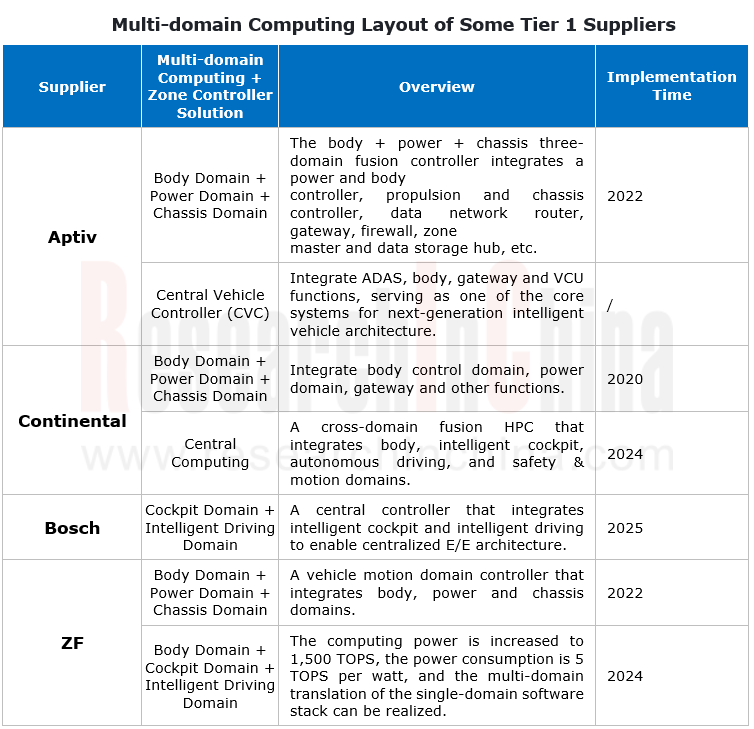
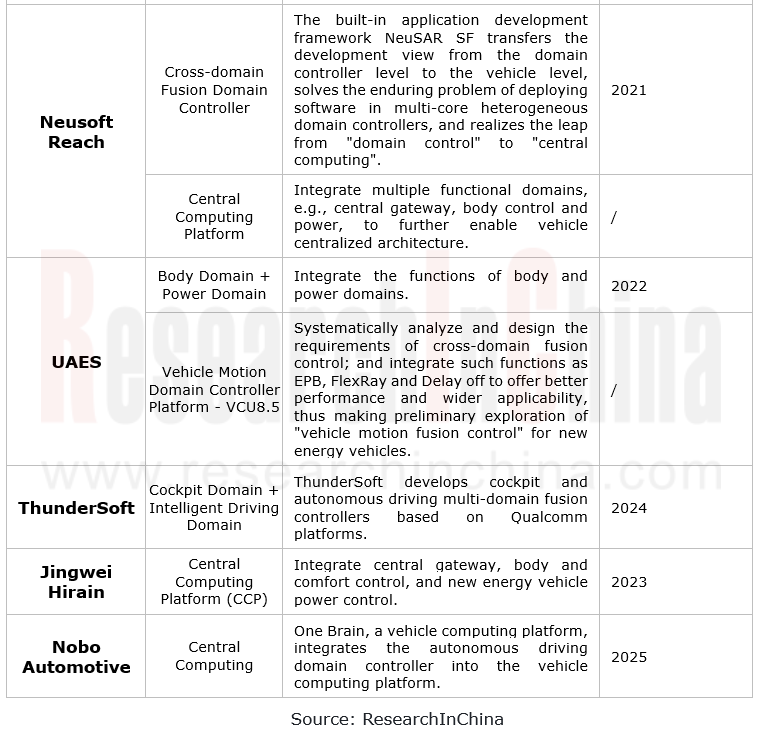
UAES
UAES has established the special cross-domain control division, and has signed strategic cooperation agreements with ecosystem partners like Horizon Robotics, Neusoft Reach, ABUP, LEADMOVE, and TE Connectivity.
In December 2022, UAES released its vehicle computing platform (VCP), which uses the new-generation NXP S32G SoC and integrates functions of power and body domains, including vehicle control, BCM and gateway. For some projects, driving assistance functions are integrated;
In May 2023, UAES launched VCU8.5, a vehicle motion domain controller platform which systematically analyzes and designs the requirements of cross-domain fusion control and integrates such functions as EPB, FlexRay and Delay off.
Continental
In April 2023, Continental exhibited its cross-domain vehicle control high performance computer (HPC) for the first time. In addition to the original body control and gateway functions, this product also integrates chassis control applications. At present, Continental has secured two local orders in China, and the model GAC Aion Hyper GT will become the first production car carrying the product. It is expected that in 2024, this HPC will be installed on more than 30 different models of several automakers.
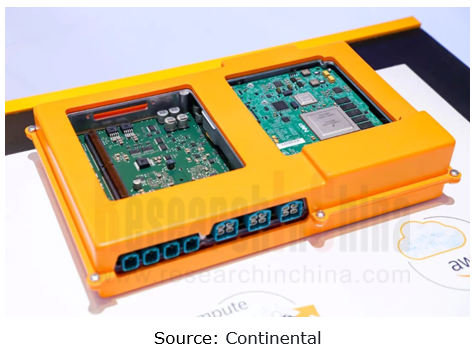
PATEO CONNECT+
In June 2023, PATEO CONNECT+ managed to develop its first vehicle central computing module (CCM). Based on the central gateway, this platform expands computing power, and integrates intelligent cockpit, ADAS, body and vehicle control functions.
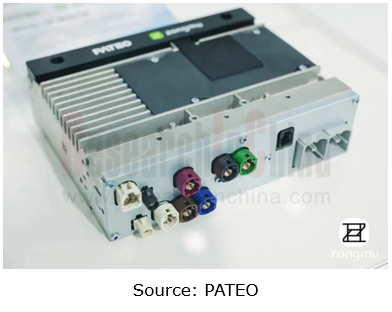
Key technical support for multi-domain computing: multi-domain computing SoC, and cross-domain fusion software platform.
At present, multi-domain fusion is seen mainly in two aspects: hardware and software. From a hardware integration perspective, multi-domain fusion features multi-SoC integration, that is, different domain controllers are integrated into one box composed of multiple SoCs or MCUs, and different functions are supported by different chips. The multi-domain fusion enabled by a single chip requires a SoC to complete different functions. There are now still some challenges in realizing single-SoC multi-domain fusion.
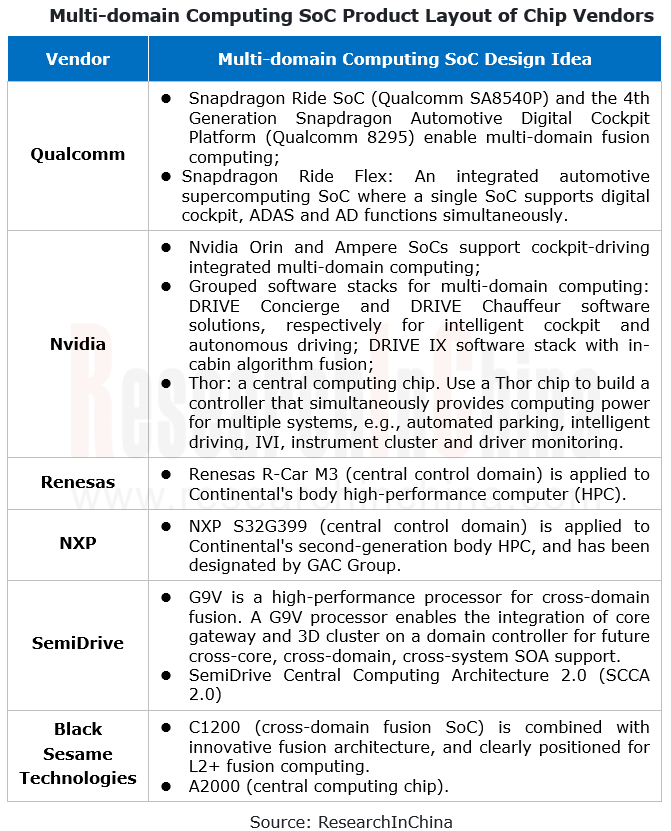
Black Sesame Technologies
In July 2023, Black Sesame Technologies announced C1200, the first product of the Wudang Series. As China’s first automotive cross-domain multifunctional fusion computing chip, C1200 meets the requirements of autonomous driving, intelligent cockpit, body control and other computing functions.
Wudang C1200 packs A78AE (performance up to 150KDMIPS), an automotive high-performance CPU core that supports lockstep, the automotive high-performance GPU core G78AE, a built-in mature high-performance Audio DSP module, and the self-developed new-generation NeuralIQ ISP module that processes 1.5G pixels per second online. Moreover, C1200 also has a built-in ASIL-D Safety Island, and a Security Module subject to the National Cryptography Level 2 and EVITA full, meeting the reliability requirements of the highest vehicle safety level.
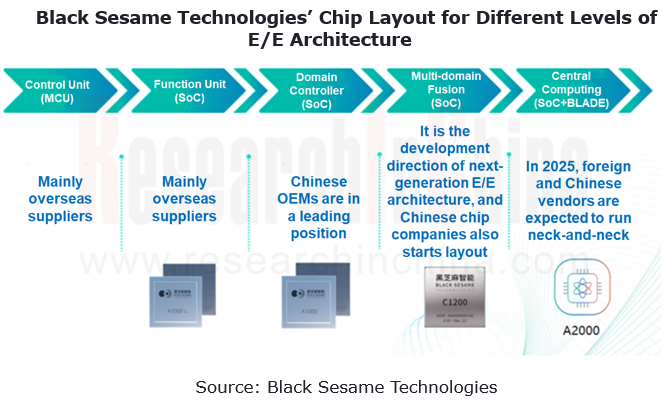
In addition to chips, the development of cross-domain fusion also needs to be supported by vehicle OS. In current stage, vehicle functional domains have yet to be fully integrated, and there is no intelligent vehicle operating system that can be applied directly for a long time in the world. This is an opportunity for Chinese vehicle OS providers to overtake on the bend.
Arraymo (ArcherMind Technology)
In April 2023, Arraymo, an arm of ArcherMind Technology, launched Fusion OS, a cross-domain fusion vehicle software computing platform which is mainly compatible with operating systems in different domains. Fusion OS quickly connects core functional domains such as intelligent cockpit, central control, and intelligent driving from the bottom layer for high integration of functional modules.
Intelligent Vehicle Multi-Domain Computing Industry Report, 2023 highlights the following:
 Multi-domain computing development ideas, including central domain controller, cockpit-driving integration, integration of cockpit and body domains, integration of chassis and intelligent driving domains, and central computing platform + zone controllers (development, main cases, etc.);
Multi-domain computing development ideas, including central domain controller, cockpit-driving integration, integration of cockpit and body domains, integration of chassis and intelligent driving domains, and central computing platform + zone controllers (development, main cases, etc.);
 Key technologies of multi-domain computing, including multi-domain fusion computing SoC, multi-domain computing software OS, multi-domain computing Ethernet, multi-domain computing gateway, and zone controller, (development trends, actual cases, etc.);
Key technologies of multi-domain computing, including multi-domain fusion computing SoC, multi-domain computing software OS, multi-domain computing Ethernet, multi-domain computing gateway, and zone controller, (development trends, actual cases, etc.);
 OEMs’ multi-domain fusion development planning, product R&D, technology layout, etc.;
OEMs’ multi-domain fusion development planning, product R&D, technology layout, etc.;
 Chinese and foreign Tier 1 suppliers’ products, technology layout, cooperation, etc. in multi-domain computing and zone controller.
Chinese and foreign Tier 1 suppliers’ products, technology layout, cooperation, etc. in multi-domain computing and zone controller.
Autonomous Driving Domain Controller and Central Computing Unit (CCU) Industry Report, 2025
Research on Autonomous Driving Domain Controllers: Monthly Penetration Rate Exceeded 30% for the First Time, and 700T+ Ultrahigh-compute Domain Controller Products Are Rapidly Installed in Vehicles
L...
China Automotive Lighting and Ambient Lighting System Research Report, 2025
Automotive Lighting System Research: In 2025H1, Autonomous Driving System (ADS) Marker Lamps Saw an 11-Fold Year-on-Year Growth and the Installation Rate of Automotive LED Lighting Approached 90...
Ecological Domain and Automotive Hardware Expansion Research Report, 2025
ResearchInChina has released the Ecological Domain and Automotive Hardware Expansion Research Report, 2025, which delves into the application of various automotive extended hardware, supplier ecologic...
Automotive Seating Innovation Technology Trend Research Report, 2025
Automotive Seating Research: With Popularization of Comfort Functions, How to Properly "Stack Functions" for Seating?
This report studies the status quo of seating technologies and functions in aspe...
Research Report on Chinese Suppliers’ Overseas Layout of Intelligent Driving, 2025
Research on Overseas Layout of Intelligent Driving: There Are Multiple Challenges in Overseas Layout, and Light-Asset Cooperation with Foreign Suppliers Emerges as the Optimal Solution at Present
20...
High-Voltage Power Supply in New Energy Vehicle (BMS, BDU, Relay, Integrated Battery Box) Research Report, 2025
The high-voltage power supply system is a core component of new energy vehicles. The battery pack serves as the central energy source, with the capacity of power battery affecting the vehicle's range,...
Automotive Radio Frequency System-on-Chip (RF SoC) and Module Research Report, 2025
Automotive RF SoC Research: The Pace of Introducing "Nerve Endings" such as UWB, NTN Satellite Communication, NearLink, and WIFI into Intelligent Vehicles Quickens
RF SoC (Radio Frequency Syst...
Automotive Power Management ICs and Signal Chain Chips Industry Research Report, 2025
Analog chips are used to process continuous analog signals from the natural world, such as light, sound, electricity/magnetism, position/speed/acceleration, and temperature. They are mainly composed o...
Global and China Electronic Rearview Mirror Industry Report, 2025
Based on the installation location, electronic rearview mirrors can be divided into electronic interior rearview mirrors (i.e., streaming media rearview mirrors) and electronic exterior rearview mirro...
Intelligent Cockpit Tier 1 Supplier Research Report, 2025 (Chinese Companies)
Intelligent Cockpit Tier1 Suppliers Research: Emerging AI Cockpit Products Fuel Layout of Full-Scenario Cockpit Ecosystem
This report mainly analyzes the current layout, innovative products, and deve...
Next-generation Central and Zonal Communication Network Topology and Chip Industry Research Report, 2025
The automotive E/E architecture is evolving towards a "central computing + zonal control" architecture, where the central computing platform is responsible for high-computing-power tasks, and zonal co...
Vehicle-road-cloud Integration and C-V2X Industry Research Report, 2025
Vehicle-side C-V2X Application Scenarios: Transition from R16 to R17, Providing a Communication Base for High-level Autonomous Driving, with the C-V2X On-board Explosion Period Approaching
In 2024, t...
Intelligent Cockpit Patent Analysis Report, 2025
Patent Trend: Three Major Directions of Intelligent Cockpits in 2025
This report explores the development trends of cutting-edge intelligent cockpits from the perspective of patents. The research sco...
Smart Car Information Security (Cybersecurity and Data Security) Research Report, 2025
Research on Automotive Information Security: AI Fusion Intelligent Protection and Ecological Collaboration Ensure Cybersecurity and Data Security
At present, what are the security risks faced by inte...
New Energy Vehicle 800-1000V High-Voltage Architecture and Supply Chain Research Report, 2025
Research on 800-1000V Architecture: to be installed in over 7 million vehicles in 2030, marking the arrival of the era of full-domain high voltage and megawatt supercharging.
In 2025, the 800-1000V h...
Foreign Tier 1 ADAS Suppliers Industry Research Report 2025
Research on Overseas Tier 1 ADAS Suppliers: Three Paths for Foreign Enterprises to Transfer to NOA
Foreign Tier 1 ADAS suppliers are obviously lagging behind in the field of NOA.
In 2024, Aptiv (2.6...
VLA Large Model Applications in Automotive and Robotics Research Report, 2025
ResearchInChina releases "VLA Large Model Applications in Automotive and Robotics Research Report, 2025": The report summarizes and analyzes the technical origin, development stages, application cases...
OEMs’ Next-generation In-vehicle Infotainment (IVI) System Trends Report, 2025
ResearchInChina releases the "OEMs’ Next-generation In-vehicle Infotainment (IVI) System Trends Report, 2025", which sorts out iterative development context of mainstream automakers in terms of infota...